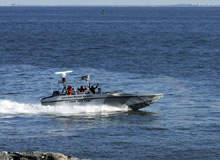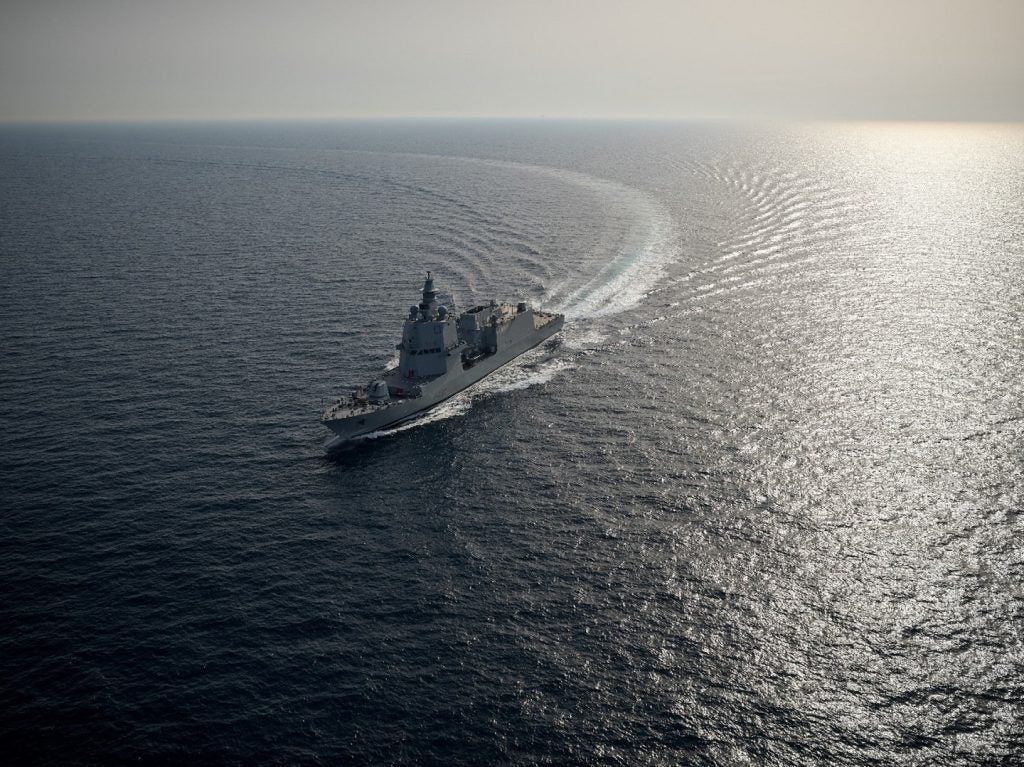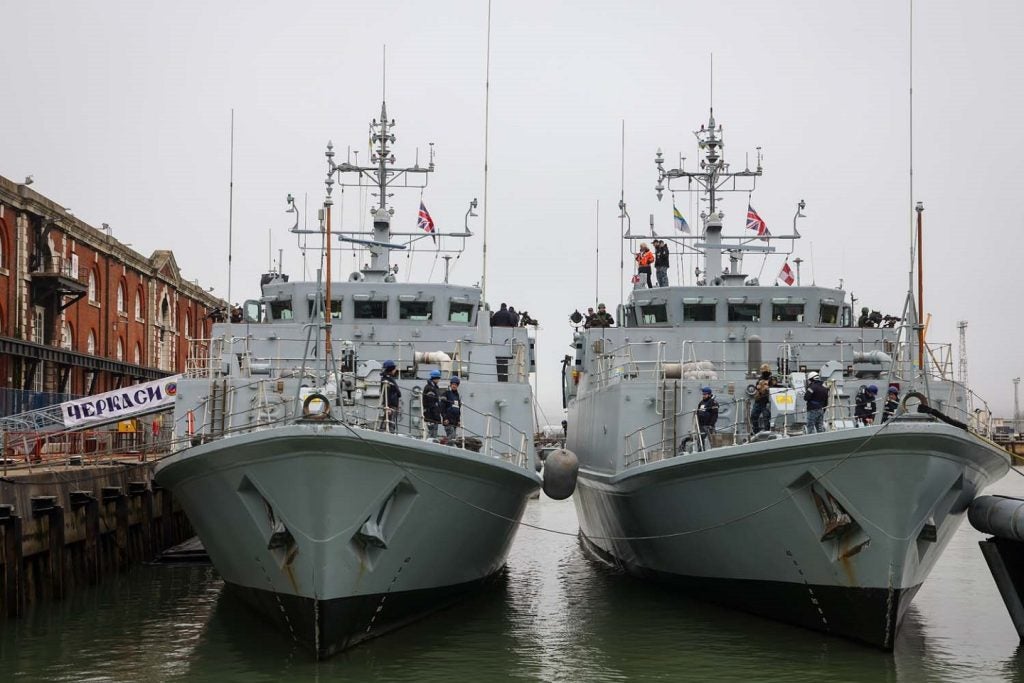
On occasion, a good exercise is to think about doing the impossible, because it may turn out to be more feasible than you thought. For naval strategists, a fruitful topic of this nature is ‘naval guerrilla’ warfare.
There are good reasons why the phrase ‘naval insurgency’ sounds like ‘fried ice cream’. Oceans don’t have civilian populations and terrain cover, the two key enablers of insurgency on land. In addition, sailors do everything inside their protective platforms, which in turn are always moving, so the soft or fixed targets just don’t exist.
But perhaps this is thinking too literally. At its core, guerrilla warfare is the use of camouflage, deception, surprise, agility and a small logistical footprint by numerically (and/or technologically) weaker combatants against stronger adversaries.
Over the past century, the submarine has acted as the de facto guerrilla warship, using the only natural cover available at sea – the water itself. However, today’s submarines are as complex, if not more so, than many of the surface ships they face.
How well do you really know your competitors?
Access the most comprehensive Company Profiles on the market, powered by GlobalData. Save hours of research. Gain competitive edge.

Thank you!
Your download email will arrive shortly
Not ready to buy yet? Download a free sample
We are confident about the unique quality of our Company Profiles. However, we want you to make the most beneficial decision for your business, so we offer a free sample that you can download by submitting the below form
By GlobalDataSimilarly, fast missile boats such as the Russian Molniya cost around $60m and carry weapons, such as the Sunburn anti-ship missile, that are not as available on the grey market as land-only weapons.
See Also:
For this discussion, guerrilla naval warfare can be said to involve combating surface ships of an enemy with fundamentally non-naval platforms, which eliminates not only diesel-attack submarines and strike aircraft, but even fast missile boats. To make the task more challenging, we will exclude marine commando tactics such as dockside assaults and seaside strikes on moored ships such as the USS Cole. Essentially, we want to determine whether it is possible to have a paramilitary navy—a ‘para-navy’?
However, before beginning, one caveat seems appropriate: guerrilla warfare is neither piracy nor terrorism. Tactically, guerrillas have it easier than pirates because the latter’s goal is seizing cargo – or for the ambitious Somalis the whole ship – which requires boarding vessels, not just destroying them. Similarly, maritime terrorists such as the Achille Lauro attack targets civilians, not armed forces.
‘Red-teaming’ maritime insurgency
Ironically, naval guerrilla warfare becomes much more feasible with the evolution of three technologies of considerable current interest to Western navies: modularity, dual-purpose patforms and unmanned maritime vehicles.
Modularity: weapons in boxes
In the naval context, modular weapons systems place launchers and munitions of different types into containers of the same size. Modular ships can swap these containers into and out of a given slot or ‘hole’ in their hull, deck, or superstructure.
In ships such as the US Navy’s LCS, modular weapons interface with the ship’s permanent C3ISR suite for maximum effectiveness. However, modular electronics systems, such as Rheinmetall‘s mk2 radars, are also available. Critically, the mk2 taps the ship’s electrical power supply through cabling that also is modular.
Many common missiles and torpedoes – along with their critical support components – can fit into a standard commercial intermodal container. The basic TEU (20ft equivalent unit) measures 20ft×8ft×8.5ft. By comparison, an Exocet missile is less than 15ft long and the British Stingray lightweight torpedo is less than 8ft long.
By design, tractor-trailer trucks can haul intermodal containers, which implies that modularised weapons can operate on land. This complicates efforts to neutralise such weapons.
Dual-purpose platforms: commerce or combat?
Western navies use commercial off-the-shelf (COTS) components in military platforms to reduce cost, but that’s not their only possible application. The converse of COTS implies building ships that can serve both military and non-military purposes.
Indeed, modular weapons can go to sea only in modularised ships but container ships already comprise the plurality of the world’s freighter inventory. Moreover, building or retrofitting smaller cargo ships with modular capacity would compound the shell-game leverage not only defensively (i.e. avoiding detection), but also offensively, by creating a potential grid of launch points for multi-axis missile attacks. Last but not least, dual-purpose ships can actually do useful civilian work, amortising their cost vis-à-vis defence budgeting.
Given that guerrilla tactics involve thinking ‘outside the box’, the multipurposing concept extends to almost any type of vessel with carrying capacity. Fishing boats, which naturally loiter and move around for reasons (fish schools) that are not obvious to a surface observer, have especially effective functional camouflage. Similarly, construction or dredging vessels have cranes and holds that can handle and conceal modular weapons.
Incidentally, this concept is neither new nor particularly unfair. Both the British and US navies used Q-ships, merchant vessels with disguised heavy armaments, as decoys against German subs in both world wars. From the underdog’s perspective, Mao Zedong famously described a ‘people’s war’ by likening guerrillas to fish swimming in a sea of people – the dual-purpose ship is almost the literalisation of Mao’s metaphor.
Unmanned maritime vehicles: blurring the lines
Spurred by the success of UAVs in Iraq and Afghanistan, Western navies are busy building robotic maritime systems, whether surface ‘bot boats’ or subsurface systems (UUVs) such as REMUS from the UK’s Hydroid. Ironically, however, unmanned vehicles are easily scalable downward for use by less sophisticated entities.
As with UAVs, UMVs range from patrol-boat sizes down to much smaller devices. At the low end of the recreational market, for example, remote-controlled speedboats around 2ft long and capable of 25mph speeds are available for as little as £25 to the recreational user.
Eliminating people, along with the ship weight and volume devoted to them, makes UMVs small, and thus eminently suitable for guerrilla tactics.
- Like UAVs, small UMVs are stealthier but unlike current UAVs, UMVs can be as fast as manned vessels due to the different physics of surface skimming relative to flight.
- UMVs can fit into containers and thus can further amplify the modularity concept. Similarly, UMVs are functionally camouflaged in some situations. For example, oceanographic research and seabed surveying ships often carry UUVs.
- UMVs can detach from the mother ship and loiter before employment. Detecting a UMV, therefore, does not imply detecting the guerrillas themselves.
- When carrying internal explosives, UMVs can act as suicide vehicles without sacrificing personnel. Again, recall ancient and recent historical precedent – the English used unmanned fireships against the Spanish Armada, and the Imperial Japanese Navy used Shinyo (suicide boats) as surface kamikazes.
Last but not least, UAVs can act as virtual naval aviation. A UAV with a camera could act as an over-the-horizon target spotter. Once a target is localised, Exocets or equivalent anti-ship missiles can handle terminal targeting with their active homing radar.





